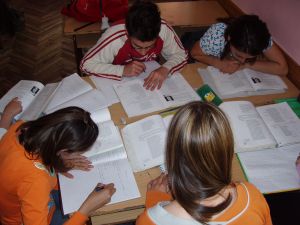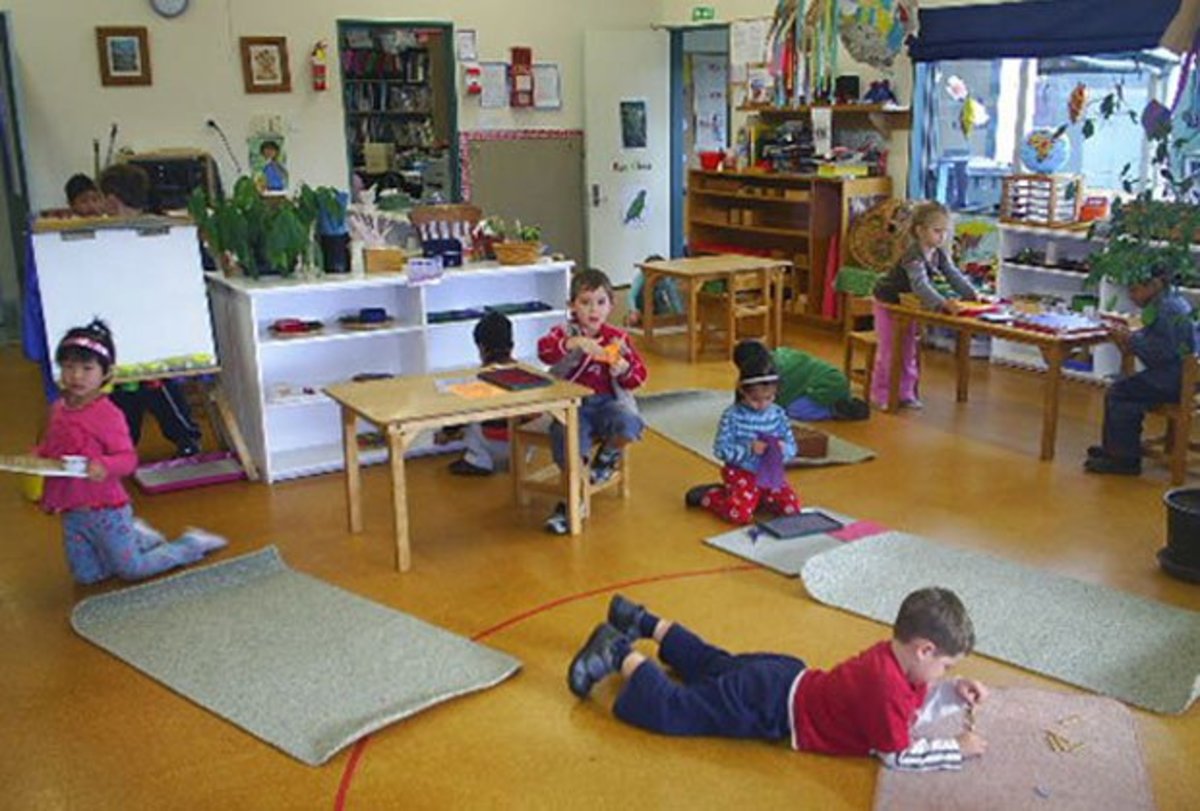Teaching in the Trenches: An Analysis of an Anonymous Charter School

Author's note:
Both the instructor who presented me with the opportunity to observe the teaching of literature at the public school I chose and the instructor who I directly observed requested that the public school which I observed remain anonymous. This is due to the extremely questionable conditions of the learning environment (which I detail later in this piece,) claiming that they were a “temporary arrangement” while the school was trying to find a new location in which to conduct classes and “getting a handle on” the EDGE program they are using as the bulk of their lessons. I had to actually promise directly to both instructors not to reveal in any way any names or identifying information that could get the school in trouble, as the situation was so bad (but the instructors I spoke with believed still had so much potential and promise) that they were afraid that, if anyone with any power were to find out, they might all lose their jobs. Why focus on such a frighteningly subpar school? Two reasons– the first is because it illustrates just how poor the education system is here in California and especially in the inner city, and secondly because even if it is an extreme example, it is still an example of something that is really going on within our education system that both the taxpayers and the taxspenders should be ashamed of. Another and, unfortunately much more “down to earth” reason that I chose this school is, if I can’t find a job when I graduate, this school is willing to hire me, and I wanted to get an idea of the kind of environment I would be teaching in before I blindly leapt into the role. In light of how bad things are, I realize that if I do decide to teach for this school, I’ll have a lot of work ahead of me if I’m going to make it passable in regards to standards, environment and actual student learning.

The School And Students:
The class that I focused on was a tenth grade literature class that was part of an inner city public school formed by instructors who had recently split from a larger public charter school conglomerate here in Northern California due to their disgust at a number of said conglomerate’s practices and policies that were disturbingly non-secular and other internal problems related to improper use of school funds and embezzlement which I will not go into in this paper. Settling in an inner city area of Sacramento where poverty is evident and everywhere, this new charter school began renting space from a tiny taqueria run by a husband and wife team of whom only the wife speaks even a halting and broken smattering of English. Only during the course of my observations did the school’s operational space expand to include the business next door to the taqueria, an even smaller, one-room unit still featuring a sign declaring it a Hispanic foods market instead of a school. At the time of my last observation, classes were still taught in the taqueria, (generally four to five students per instructor attending on average, with multiple instructors teaching their class groups at the same time in the same dining area) but “private” student-instructor meetings were being held at instructors’ shared desks (with materials coming from a series of shared filing cabinets) in the market instead of requiring instructors to use their parked cars as offices. Not to sound dramatic, but I was literally moved to tears by the squalidness of the learning conditions, the “rewards” which instructors offered students in order to encourage participation (one instructor purchased tacos for students who pushed themselves extra hard on exercises), and the way in which the students responded to their instructors. I remember being a high school student; I remember how insolent they can be, how crude and crass and lazy, but this group of students was more disengaged from the schooling experience than any group I have ever seen, and by no fault of the instructor’s that I could see. She approached the material in a way that was as interesting and engaging as seemed possible, keeping the students constantly involved, but it wasn’t enough. The rate of absences was so high that out of a class of eight students, there were literally never more than five students present in class at any given point, and never consistently did the same students attend. Those who did attend were highly disruptive to class behavior, often talking over, ignoring or insulting the instructor in displays of male camaraderie (there was only one female in the class and she was often absent, reminding me in retrospect of the “Open Poem for the Guidance Director” at the end of an article by Ellis) often involving being proud about what even they considered to be a lack of intelligence. At one point, as the instructor set her students up with a series of instructions for a period of “free work” in the workbook, then got up for a break and left me “in charge” of her class (there were three students that day) only one of the students actually did any work, and even that was cut short when he asked one of his fellow students how far he’d gotten. The other’s reply: “Dude, I’m still on page ten” not only prompted the other student to smile, but to actually put down his pencil and stop working as he asked: “For real?” The response was put forth with all the “coolness” of the second student putting the brim of his hat over his eyes and saying “For real. That’s how I roll.” I didn’t say anything to them because the instructor had informed me beforehand that one of them was heavily involved with a gang and actually had been placed in that class (as opposed to other similar sections) so that his “affiliation” wouldn’t make him “honor bound” to kill other students. Whether this was an exaggeration or actual fact, I didn’t really care to find out, so I took the safe route and avoided doing anything that might give him a reason to target me as an outsider. Rest assured that if I am faced with a similar situation as an instructor, I will act proactively in turn, responding as an authority figure should, as that will be my expected role within the classroom.
To my credit, the class I was observing didn’t merely act this way when the instructor was gone. Even during exercises, students had to be constantly hounded to participate, right down to the instructor constantly reminding them to “read with their fingers” (by tracking along the sentences with the tip of their index as they read) because without the framework of her incessant urging, they would drop away, talk or loudly feign sleeping right in the middle of the exercise, even when the turnout was only three students to a single instructor! Beyond even this, the students felt perfectly comfortable insulting the instructor to her face during exercises; the worst example I saw of this kind of behavior was when the instructor was addressing “vocabulary words” from a short story that they had just read as a class and, upon asking the students “Do you know what ‘disrespect’ is? Do you know what it means if someone is ‘disrespectful?’” one of the students immediately responded with “Kind of like when I was banging your mom last night? That’s disrespectful” and then high-fived the student across the table from him. Granted, the instructor took it in stride and, much to her credit, easily stated “yes, yes that would be disrespectful” before moving on to the next vocabulary word, but that was just a single example in a sea of consistently similar behavior which I found shocking and absolutely unacceptable.

Materials And Methods Used:
The material being used within the class was the Harcourt Brace EDGE Program, giving the class itself a sort of a “leg-up” approach which focused on “real world” applications for schooling with an emphasis on raising the reading levels of disadvantaged students with abysmal GPAs, especially those who had been expelled from a number of schools in the area and had nowhere else to go. The goal of this EDGE program, as it was imparted to me by the instructor, is essentially to take these disadvantaged kids in danger of becoming highschool dropouts and quickly boost their reading skills through an intensive program which, if they successfully complete it by raising their reading level to match their grade level, stands as the equivalent of a College Prep English course. Students are broken into small groups (8-10 student classes) that attend once per week, but at different times and on different days, divided by grade level. The group I chose to observe was the tenth grade Friday group, but considering the fact that there were two other classes going on at the same time in the same tiny taqueria, one of them literally a foot away from the back of my chair, I couldn’t help but observe (at least to some degree) some of the teaching practices that were going on in them as well.
Most of the teaching in the tenth grade class was more a form of guiding, the instructor guiding the students as a class through a workbook with the literature kept in its own book as a text to be referred back to so students could answer questions in the workbook. I kept hoping for some break to the monotony of it all as I attended session after session, but there was none. Day after day, the students hammered their way through pages in the workbook, read stories and then pushed through the workbook again. Referring back to Ellis, most of the “teaching” focus fit into the categories of Knowledge and Application, as the work they did was strictly straight memorization and exposure to literature separated by short periods of application, where students were asked about what they had learned and how it relates to real life. I saw no real encouragement or use of teaching strategies involving the categories of Interpretation or Judgment.

This Isn’t The Literature I Remember:
Perhaps the most disturbing aspect of the instruction that I observed (beyond the setting) was the fact that, even with the number of sessions that I observed, there was no exclusive and direct instruction of literature; that is, literature was not taught in any way that seemed to be entirely focused on literature for literature’s sake in the way that it was when I was in high school and texts were assigned, read in class and then addressed through conversation and testing. Instead, the instruction of literature by the teacher I was observing was consistently much more focused on increasing student vocabulary through literature by having students take turns reading aloud from literature pieces that were so short they were little more than vignettes and flash fiction. Two of the pieces that were taught during my observation were “skins”, by Joseph Bruchac and “Two Kinds”, by Amy Tan, along with a series of other one page pieces (one almost every session) which had no titles. None of the stories I observed being used in this manner were familiar to me as more “canonical” pieces I was assigned during my time in highschool would have been, but considering the aim and purpose of the school I did my observation at, perhaps exposing students to this kind of contemporary literature (no long-dead authors here!) instead of more archaic forms (like Shakespeare) presented in a format which is almost identical to a magazine (complete with quote excerpts bolded and enlarged in the middle of a text to catch the reader’s eye) is the most intelligent approach.
I did notice something much more in line with what I remembered from my time in High School in the teaching environment of the twelfth grade Literature class whose table was literally a foot or so from my back as I observed the tenth grade instructor with her students. In the twelfth grade class, the instructor was working with close to ten students (most of whom showed up consistently) through more classic literature, primarily addressing “A Tale of Two Cities” while I was there, and she stated later, when I interviewed her after class, that they were going to be spending a great deal of time addressing “British Literature”, a statement consistent with what Ellis points out in the article “What are you teaching?”, though I saw none of the author focus mentioned in the same article as being associated with this literary slant of twelfth Grade. Instead, the focus of the instructor was more on mechanics, teaching vocabulary (Much as the tenth graders were learning it from simpler material) and teaching to the standards directly by discussing genres and subgenres (Literary Response and Analysis Standard 3.1) and analyzing imagery (3.4).
The closest thing I observed throughout the entire experience to direct instruction of literature in the tenth grade class was during individual conferences, in which the instructor would sit down with the students, discuss their work as a whole, and then ask them a few basic questions about an assigned book (such as “can you tell me a little about the book” or “what was your favorite part?”) before engaging the student in a loose and somewhat casual conversation about the text. Sometimes the students’ responses were strong and showed a clear depth of understanding, but mostly their responses were little more than shrugs and simple sentences like “I liked it. I thought it was good.” Two that I observed hadn’t even read the text assigned and offered excuses like “I didn’t get around to it.” or “I forgot to read it.” Instructor responses in both cases were long lectures of the importance that reading, writing, and getting at the very least a highschool diploma have to leading a productive and meaningful life, but especially in regards to their merits in getting a job in the “real world.”

In Contrast With Blau:
When we look at the lessons, practices and activities put forth by Blau in The Literature Workshop, it seems as if there is an incredible amount of room for improvement in regards to the way literature is taught (or rather the way it is not taught) at this particular public charter school. I didn’t observe many activities within the approaches taken in teaching literature at the school that were at all similar to any of those suggested by Blau; there were no reading logs or journals, and no written work really at all, except what was written in short, ten line sections of vocabulary enhancing writing exercises that were part of the workbook. About the only thing that seemed in keeping with the strategies put forth by Blau (and many of the other readings we’ve discussed in the class, such as Wooden Shack Place) was the use of some peer response in regards to the literature being taught as part of the larger textbook, though it was extremely limited and nowhere near as developed as what Blau, Hull, Rose or others have suggested. Instead of providing small groups designed for students to talk among themselves about a piece of literature and then sharing with the class their findings and interpretations of it, the peer dynamic at the school I was observing consisted more of small groups of students (an entire class, essentially) that included the teacher as part of the peer process in a sort of simple forum where simple topics were discussed openly and in a conversational fashion, like “Was it good, did you like it?” or “What do you think that the author is trying to say?” These sessions usually took up less than five minutes of class time, though I recorded one session as long as twenty-two minutes while students were discussing Joseph Bruchac’s “Skins”. Most of the sessions, unfortunately, consisted of the instructor simply guiding the students through their workbooks, making sure that they paid attention to the material, and taking breaks from the workbooks and text to briefly discuss individual vocabulary words featured in the literature that was read, and not the actual literature itself.

Fulfilling The Standards:
In comparison to the California standards for grade 10, there are already problems; the students involved with this school are all so far below standards anyway that they’re involved in material which fulfills lower grade standards in order to get them caught up. A few sections of the workbook seemed to address some of the standards very directly while I was there (such as Structural Features of Literature standard 3.2, which focuses on a student’s ability to “compare and contrast the presentation of a similar theme or topic across genres to explain how the selection of genre shapes the theme or topic”, but was there any instruction which echoed the standards for Narrative Analysis of Grade-Level-Appropriate texts? (3.3-3.10) Not that I saw; texts analyzed while I was observing all seemed like sixth to eighth grade material.
Another serious problem with the school’s approach to teaching literature (in regards to the standards) is in the way that novels are assigned almost arbitrarily and students who are already having problems in school are asked to read them on their own time. While this is a great supplement to teaching literature in more conventional venues of the school system, in a public charter environment where students are spending a minimal amount of time with an instructor, it leaves too little guidance (in my opinion) when it comes to the standards. After all, we cannot just hand a tenth grader a novel or a piece of classic literature and just expect him or her to magically meet all the standards that California has for its students. They aren’t going to be able to critically analyze anything (Reading comprehension standards) just by reading a fiction book or a handful of short stories. I mean, theoretically, you could argue that standards for Writing Strategies like Organization and Focus 1.1 are met by a student writing out a thesis in a space in his or her workbook, or that the standards for Speaking Applications like 2.4 (Delivering oral responses to literature) are met by students who say “it was good” or state basic facts about assigned reading, but is that really wise? The standards are the very framework upon which the curriculum is based; they provide for instructors the recipe for helping students achieve a modicum of competency with the English language, and if we as instructors skimp on them or cut too many corners, our students will ultimately fail, no matter what grades they receive in our classes. Attention and involvement are the keys to helping our students, especially our disadvantaged students, become competent users of the English language and, with a little luck, lifetime readers.

Summary:
“I think it’s better than my last school.” One of the students I interviewed stated when I asked her what she thought about the program, and that, I think, is kind of sad. If the high schools that students like the above went to were worse than being taught out of a workbook in a taqueria, then our education system is worse than I thought it was. The ideas themselves presented by the EDGE program definitely have potential, I’ll give the instructors I spoke to outside of class that much, and the fact that the aim of the EDGE program is to give disadvantaged kids a quick-fix when it comes to whether or not they’re going to graduate is definitely a plus. The bottom line is that it may work; the system didn’t iron out any of the personal problems that students had or make them more interested in the material, but they made progress within their workbooks and I’m sure some of them will be much better off in the end because of it. In the light of discussions and readings presented as part of this class, however, I don’t think it’s the best way to go about teaching literature. Not only is the classroom environment provided by this school abysmal, but the teaching methods, while put forth by teachers who are quick and engaging, fighting tooth and nail to keep students on track whenever they are present, don’t amount to much more than aggressive babysitting while the teaching is done in tandem by the text and the workbook. It is a travesty to see students in the tenth and twelfth grades being taught by workbooks in taquerias so that they can be “prepared” for adulthood and the jobs that await them. There are good ideas here, (the small class size, the intensive approach of the edge program, the much more open, charter approach, etc.) but they aren’t being implemented in a way that is conducive to helping students learn. How much can we really expect our students to learn if their teacher is a book and their school is a taqueria? Changes need to be made and, even if I do not end up teaching there, I’ve requested a meeting with several of the more open instructors there to discuss the findings of this paper over the break in the hopes that my insights will change that school for the better.








